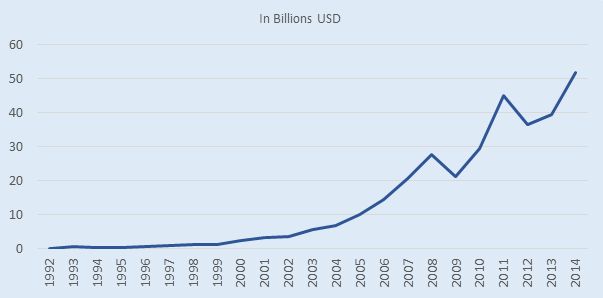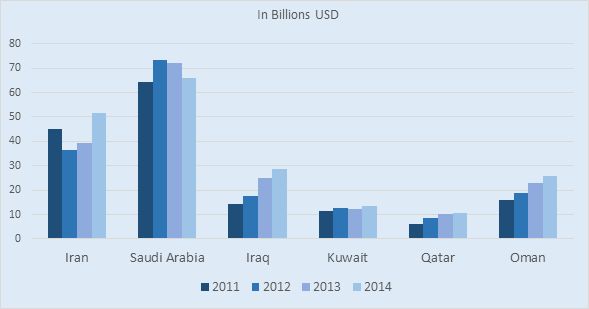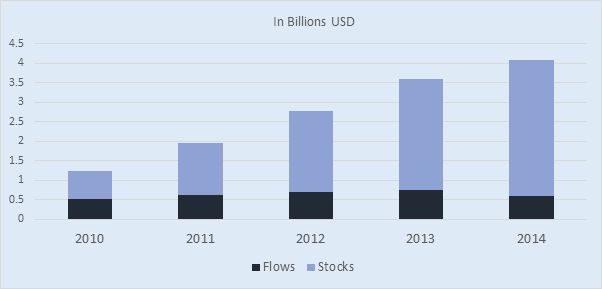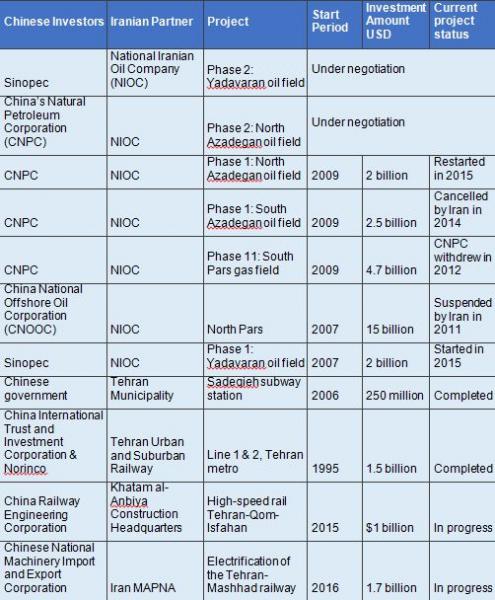This essay is part of the series “All About China”—a journey into the history and diverse culture of China through essays that shed light on the lasting imprint of China’s past encounters with the Islamic world as well as an exploration of the increasingly vibrant and complex dynamics of contemporary Sino-Middle Eastern relations. Read more ...
This essay examines China-Iran trade relations, as well as Chinese investments in Iran. Particularly, it asks whether the stated Chinese-Iranian ambition to increase the value of bilateral trade to $600 billion within a decade is attainable. Additionally, it identifies the factors responsible for the trade deficit in Iran’s favor, and shows that the pace of China’s foreign direct investment (F.D.I) in Iran is slowing in spite of absolute increases.
Exaggerated Ambitions
The Iran-China commercial relationship has developed considerably since 1979, when China adopted its Open Door Policy and the Iranian Revolution took place. Within a decade, the volume of bilateral trade rose to approximately $400 million.[1] By 2014, the value of bilateral trade had reached $51.8 billion (see Chart 1). The growth of the Iran-China Chamber of Commerce and Industries (I.C.C.C.I.), from 65 members in 2001[2] to 6,000 today furnishes additional evidence of the expansion of the relationship.[3] Against this backdrop, during his January 22-23, 2016 visit to Iran, President Xi Jinping confidently pledged to promote trade ties to the value of $600 billion in ten years.[4] But is this objective attainable? One way to find out is by putting this figure in perspective.
$600 billion is approximately 33 percent larger than the current size of Iran’s economy, which was valued at $406.3 billion by the World Bank in 2014.[5] The five-year plan before the Iranian Majlis is aiming for an average 8 percent growth rate.[6] Similarly, the World Bank projects that Iran’s real G.D.P. should rise to 5.8 percent and 6.7 percent in 2016 and 2017, respectively. Therefore, under ideal conditions, if one was to take the optimal growth rate of 8 percent at a constant rate for ten years, the size of Iran’s economy would amount to $876.52 billion, approximately, in 2025. Thus, the $600 billion bilateral trade target would roughly equate to two-thirds of Iran’s G.D.P. a decade from now.
In 2011, without giving a timeframe, Iranian officials had expressed hope that trade with China would quickly increase to $100 billion.[7] Five years later, this objective had not been attained, and was subsequently revised with new expectations for trade to reach $60 billion by March 2016.[8] In fact, from 2011 to 2014, the value of trade increased by just $9 billion approximately (see Chart 1 or 2). Therefore, if past measures are anything to go by, Sino-Iranian ambitions of $600 billion within a decade are to be taken with a pinch of salt. In fact, the two countries seem inclined to exaggerate what is achievable. If anything, the past has shown that China’s trade with Iran has grown incrementally and has, at times, suffered setbacks partly due to sanctions on Iran (see Chart 1).
Chart 1: China-Iran Bilateral Trade

Source: UN Comtrade
The China Deficit
During the sanctions' years, China was one of a handful of countries that continued trading with Iran. Despite the stringent economic conditions that Iran operated under, China has always run a trade deficit with Iran. That is because a substantial portion of Sino-Iranian trade is composed of petroleum-based products. Suited to Iran’s strategy of raising iron ore exports to compensate for lost revenue due to sanctions on oil sales, Chinese buyers of iron ore have also viewed Iran as an alternative to their traditional suppliers Australia and Brazil.[9] In 2014, according to official Chinese data, China’s imports from Iran stood at $27.5 billion whereas its exports to Iran were $24.3 billion.[10] In 2011, 2012, and 2013, that gap, in favor of Iran, was much larger.
Following the imposition of European Union sanctions against Iran, and faced with the threat of U.S. financial sanctions, China reluctantly agreed to curtail its purchases of Iranian oil, and did so only until conclusion of the November 2013 interim nuclear accord.[11] Thereafter, China’s oil imports quickly returned to pre-2012 sanctions levels.[12] While this dependence signals a trading advantage for Iran, until now, as a result of European firms’ withdrawal from the Iranian market, Iran has had reduced negotiating leverage with China. Thus, Iran was dependent on China because it had a limited choice of oil export markets. The relationship worked in symbiosis. However, now that the nuclear sanctions are gone, Iran is in a better negotiating position vis-à-vis China. One can expect a decline in Iran’s exports to China as a percentage of the former’s overall exports and push the trade balance further towards China.
China currently exports a wide range of products to Iran, including machinery, electrical and electronic equipment, vehicles, and lighting. That said, its exports to Iran are not about to jump from $24 billion to several hundred billion in ten years, particularly given the fact that Chinese exports worldwide are in decline.[13] Furthermore, during the sanctions period, in the absence of rivals, Chinese groups doing business with Iran charged higher prices and were slow to deliver.[14] This behavior tainted the image of the Chinese among Iranian customers, who had little choice but to use Chinese products, which had a quality inferior to those made in the West. With sanctions removed, and the return of Western firms to Iran, the marketability of Chinese goods, such as cars, has dropped. [15] Furthermore, the speed of growth of trade with China can be expected to decrease, particularly as the risks of doing business with Iran decline. Consequently, Chinese firms will have less room to maneuver.[16]
That said, Iranians are not about to abandon trade with China. Many Iranians still view China as having befriended Iran during the sanctions years.[17] In addition, despite the current decline in China’s exports, its share of global exports is increasing. So, too, is the volume of China’s export of refined petroleum products, which Iran imports due to limited domestic refining capacity.[18] This is an additional factor which could further boost China’s share in the bilateral trade relationship.
Chinese and Iranian leaders might be attributing more importance to the impact sanctions had on the relationship than was actually the case. Rather than trade growing exponentially without sanctions, we should expect growth in trade to be constant, equivalent to China’s other Middle Eastern trade relationships. Chart 2 shows that growth in trade is more or less constant in all Middle East nations—which were not affected by sanctions—Sino-Iranian trade does not substantially differ in this regard.[19]
Chart 2: China-Middle East Bilateral Trade
Source: UN Comtrade
The Investment Slow Down
As part of China’s reform efforts in the area of domestic and foreign investment, China’s Ministry of Commerce has been negotiating bilateral investment treaties with a number of countries including the United States and the European Union, and negotiations with Kazakhstan and Iran started in 2015.[20] Iran also became the 34th founding member of the Asian Infrastructure Investment Bank (A.I.I.B.), which was launched by China in 2014 with the objective of financing infrastructure projects in Asia.[21] With 57 founding members, Iran’s membership is of limited significance. More than anything the move is symbolic, given Iran’s previous isolation from the world’s banking systems. Iran purchased a 2.8 percent stake in the bank while China is expected to invest $50 billion in order to own a 50 percent stake.[22]
China’s Ministry of Commerce estimates that total outward direct investment (O.D.I.) for 2014 stands at around $123 billion,[23] 14 percent higher than the previous year.[24] In 2011, Iran ranked 12th as a destination for Chinese F.D.I. flows, receiving about $615 million,[25] but three years later dropped to 22nd place and $600 million.[26] From 2012 to 2014, the Iranian share of China’s overall F.D.I. flows fell each year.[27] In terms of stocks, although China’s total investments have been increasing, Iran’s ranking as a choice of investment destination has remained more or less stable (e.g., 22nd position in 2011,[28] 23rd in 2014[29]). Thus, the expectation of widespread growth in China’s investments in Iran following sanctions relief is not necessarily going to become fact.[30]
To explain further, it is worth considering two trends in China’s O.D.I. decisions. The first of which is that China is investing in new sectors beyond resource extraction.[31] Secondly, in lieu of the former, China’s investment destinations are changing from resource-rich developing countries to developed countries capable of providing access to advanced technologies, established brands, and extensive industry experience.[32] The destinations for China's outward investment are becoming increasingly diversified, as Chinese companies are expanding into the developed countries in Europe and America rather than the resource-based economies in Asia, Africa and Latin America. Thus, even considering Iran as an emerging market does not bode well for China’s future investments in Iran.
Chart 3: China Outward F.D.I. in Iran
Source: National Bureau of Statistics of China, Ministry of Commerce
Oil and Gas False Starts
In Iran’s oil and gas sector, projects involving China’s state-owned energy firms have been hampered by disagreements over contract terms, repeated delays, and cancellations. Between 2010 and 2014, while Iran was under the heaviest sanctions, China grew increasingly hesitant to see through its promised investments. The most expensive example for Iran came with the suspension in 2011 of an agreement with China National Offshore Oil Corporation (CNOOC) for development of Iran’s North Pars gas field.[33] CNOOC reportedly slowed down work on this project due to growing ties with U.S. energy companies, which further exposed Chinese companies to U.S. sanctions.[34]
In 2012, the China National Petroleum Corporation (C.N.P.C.) also withdrew from development of Phase 11 of South Pars gas field after constant delays.[35] Regional instability including an escalation of tensions between the U.S. and Iran, project workers’ safety, poor logistics, and minefields left over from the Iran-Iraq and Gulf wars were given by China as explanations for the delays.[36] In 2014, Iran also cancelled C.N.P.C.’s contract for development of the South Azadegan oil field amidst a surge in production in U.S. markets and China’s reduced concerns over scarce global oil supplies.[37]
Production of the first phase of both the North Azadegan oil field and the Yadavaran oil field only got underway in 2015, despite the contracts having been signed in 2009 and 2007, respectively.[38] In a mark of progress since the Iranian nuclear deal, discussions are now underway for development of phase two of both of the latter fields.[39] However, funding for these investments seems likely to come from the recovery of Iranian oil export revenues blocked in Chinese banks since the era of sanctions.[40] Henceforth, despite Iran having been China’s fifth largest oil supplier in 2014 (down from third place in 2012),[41] China’s investments in Iran’s oil and gas sector have been plagued by troubles, and the extent of future investments remains, for the moment, uncertain.
Transport Infrastructure: A Mixed Bag
In terms of rail projects, while some projects have progressed, others remain on the drawing board. As part of China’s One Belt One Road initiative, China’s railway authority has proposed a high-speed railway from northwest China via the Central Asian countries of Kazakhstan, Kyrgyzstan, Uzbekistan, and Turkmenistan, to Iran.[42] While this proposed route presents an alternative to the northeast-southwest railway network towards Moscow, the likelihood of such a large-scale project materializing remains doubtful for as long as the countries along the route remain integrated into the post-Soviet political and economic space.
Another high-speed rail project under discussion is the Tehran-Qom-Isfahan express railway. This rail project comprises two segments, firstly the Tehran-Qom link and secondly the Qom-Isfahan link.[43] Funding seems to have been agreed through China’s Export and Credit Insurance Corporation, and implementation is expected to be carried out by China Railways Engineering Corporation (CREC) in cooperation with Iran’s Khatam al-Anbiya.[44] In 2015, China’s National Machinery Import and Export Corporation (CMC) and Iran Mapna also agreed on a deal to provide financial aid for electrification of an existing rail link connecting Tehran to the northeastern city of Mashhad, Iran’s second largest city.[45]
At the city level, according to Iranian officials, China’s Norinco has also been selected to build monorail and subway projects in Qom,[46] but there was no word from China thus far on any such project. Also at the city level, in 2014, the China International Trust and Investment Corporation (CITIC) signed a memorandum of understanding (MOU) with the municipality of Tabriz for the construction of a tramway, but no progress reports have been made since.[47] Cooperation between CITIC and Norinco with the Tehran Urban and Suburban Railway for construction of lines one and two of the Tehran Metro was the flagship of Sino-Iranian relations in the late 1990s and 2000s.[48] Construction of these lines was completed in 2006 while construction of Sadeghieh station on Tehran metro has also been financed by the Chinese government.[49]
A final transport infrastructure project to be mentioned and carrying geopolitical implications is a Chinese investment in Chabahar Port in Iran’s southeastern province of Sistan and Baluchestan close to the Pakistan border. For a long time, upgrading this port has come under the purview of India’s foreign policy but, between U.S. pressure, and Iran and India stumbling around the negotiations,[50] Chinese officials began to express an interest.[51] That said, since the nuclear deal, India and Iran seem to have reconfirmed their joint commitment to developing the port by signing a new a MOU and by India’s approval to provide Iran with a corresponding line of credit.[52] Henceforth, China’s room for maneuver is restricted. On the whole, China’s investments in Iran’s transport infrastructure, particularly in railways, seems to be on sounder footing than cooperation in the oil sector. A number of projects are making good progress, while only a couple remain far from realization.
Table 1: Chinese Investments in Iran
Note: Compiled by author from a variety of sources.[53]
Conclusion
In sum, China’s relations with Iran are not as intense as the impression often given by Western media reports. In fact, the results here show that China-Iran relations actually defy expectations. Bilateral trade relations are not advancing as quickly as the two countries envision, and in some measures, they do not differ greatly from China’s relations with other Middle Eastern countries. China’s foreign direct investment in Iran is not increasing as a proportion of China’s overall investments, and indeed Iran is falling in the rankings as a choice of destination for Chinese investors. Investments in the oil and gas sector have been plagued by delays, and progress on new projects remains uncertain. While investments in the rail sector overall seem to fair better, transport infrastructure projects are a mixed bag because a number of them are either in the early stages or are merely envisioned geopolitical plans.
[1] See US-China Economic And Security Review Commission, China-Iran: A Limited
Partnership, (2013), accessed March 22, 2016, http://www.uscc.gov/sites/default/files/Research/China-Iran--A%20Limited%20Partnership.pdf; and “U.N. Comtrade Database, Beta Trade Data Extraction Interface,” accessed March 22, 2016, http://comtrade.un.org/data/. The Iran-China Chamber of Commerce and Industries (I.C.C.C.I.) maintains that trade valued at approximately $400 million in 1990, while an article in Xinhua gives a figure of $331 million for 1991. Reporting to UNComtrade begins in 1992, and $436.6 million is the figured reported by China for that year.
[2] History, ICCCI, May 13, 2010, accessed March 15, 2016, http://en.iran-chinachamber.ir/index.php?option=com_content&view=article&id=1&Itemid=11; “Iran-China Chamber of Commerce and Industries (I.C.C.C.I.),” Second Forum of Iran-China Investment opportunities, July 18, 2012, accessed March 15, 2016, http://en.iran-chinachamber.ir/index.php?option=com_content&view=article&id=364:second-forum-of-iran-china-investment-opportunities&catid=33:july-2012&Itemid=39.
[3] See “Promotion of Business between Iran and Jilin Province,” ICCCI, September 19, 2012, accessed March 15, 2016, http://en.iran-chinachamber.ir/index.php?option=com_content&view=article&id=382:promotion-of-business-between-iran-and-jilin-province&catid=35:september2012&Itemid=41; and Canton Fair – Media Resource Exchange Program (MREP) accessed March 25, 2016, http://www.cantonfair.org.cn/en/mrep/detail.aspx?oid=30149.
[4] “Iran-China trade to touch fresh high of $600bn in 10 yrs,” Mehr News, January 23, 2016, accessed March 15, 2016, http://en.mehrnews.com/news/113806/Iran-China-trade-to-touch-fresh-high-of-600bn-in-10-yrs.
[5] “Iran Overview,” The World Bank, Updated September 29, 2015, accessed March 22, 2016, http://www.worldbank.org/en/country/iran/overview.
[6] See Ivana Kottasova, “Iran: We’ll grow 8% soon,” CNN Money, January 20, 2016, accessed March 15, http://money.cnn.com/2016/01/20/investing/iran-economic-growth-davos/. This figure given by Mohammed Nahavandian, Chief of Staff to Iran’s President Hassan Rouhani, while speaking at the 2016 Annual Meeting of the World Economic Forum, in Davos, Switzerland.
[7] See for example: AP, “Iran seeks to triple China trade to $100 billion,” CNSNews, July 16, 2011, accessed March 23, 2016, http://cnsnews.com/news/article/iran-seeks-triple-china-trade-100-billion.
[8] “Iran-China trade balance to hit $60b,” Iran Daily, March 13, 2015, accessed March 15, 2016, http://www.iran-daily.com/News/113759.html?catid=3&title=Iran-China-trade-balance-to-hit--60b.
[9] “Iran boosts iron exports to China, India,” Iran-China Chamber of Commerce and Industries, September 3, 2013, accessed March 15, 2016, http://en.iran-chinachamber.ir/index.php?option=com_content&view=article&id=462:iran-boosts-iron-exports-to-china-india&catid=48:september--2013&Itemid=66.
[10] “U.N. Comtrade Database.”
[11] Timothy Gardner and Roberta Rampton, “U.S. extends waivers on Iran sanctions to China and India,” Reuters, December 7, 2012, accessed March 23, 2016, http://www.reuters.com/article/us-usa-iran-sanctons-idUSBRE8B615M20121207.
[12] Judy Hua and Chen Aizhu, “Update 1-China’s March crude imports from Iran up 36.1 pct y/y,” Reuters, April 21, 2014, accessed March 15, 2016, http://uk.reuters.com/article/china-crude-iran-idUKL3N0ND0M520140421.
[13] Mark Magnier, “Chinese exports post biggest decline since 2009,” Market Watch, accessed March 15, 2016, January 13, 2016. http://www.marketwatch.com/story/chinese-exports-post-biggest-decline-since-2009-2016-01-13.
[14] Najmeh Bozorgmehr, “China ties lose lustre as Iran refocuses on trade with west,” Financial Times, September 23, 2015, accessed March 15, 2016, http://www.ft.com/intl/cms/s/0/9d1564bc-603f-11e5-a28b-50226830d644.html#axzz41yYYlUFp.
[15] Ibid.
[16] Ibid.
[17] See for example the comments of Supreme Leader “Ali Khamenei: ‘Iran will never forget China’s cooperation during the time of sanctions,’” Khemenei.ir, January 23, 2016, accessed March 15, http://english.khamenei.ir/news/3212/Iran-will-never-forget-China-s-cooperation-during-the-time-of.
[18] Leslie Hook, “U.S. Acts against Chinese Oil Trader,” CNN, January 18, 2012, accessed March 15, http://edition.cnn.com/2012/01/13/business/us-china-iran-oil/index.html.
[19] Chart 2 also shows that in 2012 and 2013, China reduced its trade with Iran in favor of Saudi Arabia as an alternative, but that dip was temporary and not substantial.
[20] See “2015 Business Review XVII: Active and Steady Promotion of the Commerce Legal Construction,” Ministry of Commerce People’s Republic of China, February 1, 2016, accessed March 15, 2016, http://english.mofcom.gov.cn/article/zt_businessview2015/news/201602/20160201261339.shtml.
[21] Angelo Young, “China Welcomes Iran, UAE To Asian Infrastructure Investment Bank; Founding Members Now Number 35,” IBTimes, July 4, 2015, accessed March 15, 2016, http://www.ibtimes.com/china-welcomes-iran-uae-asian-infrastructure-investment-bank-founding-members-now-1872553.
[22] See “Iran buys shares of AIIB multinational bank,” Mehr News, October 27, 2015, accessed March 15, 2016, http://en.mehrnews.com/news/111402/Iran-buys-shares-of-AIIB-multinational-bank.
[23] Ministry of Commerce of People’s Republic of China. 2014 Statistical Bulletin of Outward Foreign Direct Investment. National Bureau of Statistics of People’s Republic of China. State Administration of Foreign Exchange (Beijing: China Statistics Press, 2015), 85.
[24] Ministry of Commerce of People’s Republic of China. 2013 Statistical Bulletin of Outward Foreign Direct Investment, National Bureau of Statistics of People’s Republic of China. State Administration of Foreign Exchange (Beijing: China Statistics Press, 2014), 81.
[25] Op. cit., Ministry of Commerce, 2014 Statistical Bulletin of Outward Foreign Direct Investment, 131.
[26] Ministry of Commerce of People’s Republic of China, 2011 Statistical Bulletin of Outward Foreign Direct Investment. National Bureau of Statistics of People’s Republic of China. State Administration of Foreign Exchange (Beijing: China Statistics Press, 2012), 74.
[27] Ministry of Commerce of People’s Republic of China, 2012 Statistical Bulletin of Outward Foreign Direct Investment. National Bureau of Statistics of People’s Republic of China. State Administration of Foreign Exchange (Beijing: China Statistics Press, 2013), 83; Op. cit., 2013 Statistical Bulletin of Outward Foreign Direct Investment, 93; Op. cit. 2014 Statistical Bulletin of Outward Foreign Direct Investment, 131-135.
[28] Op. cit., Ministry of Commerce, 2011 Statistical Bulletin of Outward Foreign Direct Investment, 79-83.
[29] Op. cit., Ministry of Commerce, 2014 Statistical Bulletin of Outward Foreign Direct Investment, 136-140.
[30] For expectations, see for example the comments of Seyed Reza Aghazadeh, Iran’s commercial attaché in China, quoted in “China’s investment in Iran to grow by sanctions relief,” Mehr News, November 4, 2015, accessed March 15, 2016, http://en.mehrnews.com/news/111645/China-s-investment-in-Iran-to-grow-by-sanctions-relief.
[31] “China Outlook 2015,” KPMG Global China Practice (2015), accessed March 15, 2016, http://www.kpmg.com/ES/es/Internacionalizacion-KPMG/Documents/China-Outlook-2015.pdf.
[32] Ibid.
[33] Joao Peixe, “Iran Suspends Chinese Contract for North Pars Natural Gas Field,” Oil Price, October 15, 2011, accessed March 15, 2016, http://oilprice.com/Latest-Energy-News/World-News/Iran-Suspends-Chinese-Contract-For-North-Pars-Natural-Gas-Field-.html
[34] “Exclusive: China slows Iran oil work as U.S. energy ties warm,” Reuters, October 28, 2010, accessed March 15, 2016, http://www.reuters.com/article/us-china-iran-oil-idUSTRE69R1L120101028.
[35] “China pulls out of South Pars project: report,” Reuters, July 29, 2012, accessed March 15, 2016,. http://www.reuters.com/article/iranchina-southpars-idUSL6E8IT0T020120729.
[36] Zhang Junmian, “Delays could end CNPC’s South Pars involvement,” China.org.cn, August 1, 2012, accessed March 15, 2016, http://www.china.org.cn/business/2012-08/01/content_26090271.htm.
[37] “Iran cancels CNPC contract in still undeveloped Azadegan oilfield,” Reuters, May 1, 2014, accessed March 15, 2016,http://www.scmp.com/news/world/article/1501261/iran-cancels-cnpc-contract-still-undeveloped-azadegan-oilfield.
[38] “Iran to Raise Crude Output in Biggest Oilfield Next Month,” Tasmin News Agency, August 14, 2015, accessed March 15, 2016, http://www.tasnimnews.com/en/news/2015/08/14/828256/iran-to-raise-crude-output-in-biggest-oilfield-next-month; “China state firms to start pumping new oil in Iran–sources,” Reuters, July 31, 2015, accessed March 15, 2016, http://www.reuters.com/article/china-iran-oil-idUSL3N10B29620150731.
[39] “China to develop N Azadegan oilfield,” Iran Daily, December 26, 2015, accessed March 15, 2016, http://www.iran-daily.com/News/133702.html; and “China state firms to start pumping new oil in Iran–sources,” Reuters, July 31, 2015, accessed March 15, 2016, http://www.reuters.com/article/china-iran-oil-idUSL3N10B29620150731.
[40] “China to Triple Funding in Iran Energy Projects,” Financial Tribune, April 16, 2015, accessed March 15, 2016, http://financialtribune.com/archive/2015/04/16/articles/energy/14671/china-triple-funding-iran-energy-projects.
[41] “China,” U.S. Energy Information Administration (E.I.A.), May 14, 2015, accessed March 15, 2016, https://www.eia.gov/beta/international/analysis.cfm?iso=CHN.
[42] Zheng Yanpeng. New rail route proposed from Urumqi to Iran, China Daily, November 21, 2015, accessed March 15, 2016, www.chinadaily.com.cn/china/2015-11/21/content_22506412.htm.
[43] “China to Build Railway for Express Trains in Central Iran,” Farsnews, April 22, 2014, accessed March 15, 2016, http://en.farsnews.com/print.aspx?nn=13930202001146.
[44] “Tehran-Qom-Isfahan High Speed Rail Project,” Iran International Magazine, October 2015, accessed March 2016, http://www.iraninternationalmagazine.com/text-sp/tehran-qom-isfahan.htm.
[45] “Tehran-Mashhad railroad electrification to use Chinese finance,” Iran Daily, June 21, 2015, accessed March 15, http://www.iran-daily.com/News/120570.html.
[46] Dalga Khatinoglu, “China to provide Iran with high speed trains,” Trend, March 18, 2014, accessed March 15, 2015, http://en.trend.az/iran/2254492.html.
[47] Umid Niayesh, “China To Implement Tram Project In Iran’s Tabriz,” Haberler, March 18, 2014, accessed March 15, 2016, http://en.haberler.com/china-to-implement-tram-project-in-iran-s-tabriz-399027/.
[48] For a detailed explanation of China’s involvement in the Tehran metro project, see John Garver, China and Iran: Ancient Partners in a Post-Imperial World (Seattle: University of Washington Press, 2006), 261-264.
[49] “Tehran Metro, Iran,” Railway Technology, accessed March 9, 2016, http://www.railway-technology.com/projects/tehranmetro/.
[50] For a brief explanation of the issues affecting the negotiation over Chabahar port, see Kabir Taneja, “India’s Missed Iran Opportunity,” The Diplomat, May 21, 2015, accessed March 15, 2016, http://thediplomat.com/2015/05/indias-missed-iran-opportunity/.
[51] For China’s interest, see for example Amitav Ranjan, “As China offers funds to Iran, India set to fast-track Chabahar pact,” The Indian Express, July 1, 2013, accessed March 15, 2016, http://archive.indianexpress.com/news/as-china-offers-funds-to-iran-india-set-to-fasttrack-chabahar-pact/1136084/1.
[52] “India approves $150 million Chabahar port plan in Iran,” The Tribune, February 25, 2016, accessed March 15, 2016, http://tribune.com.pk/story/1054246/india-approves-150-million-chabahar-port-plan-in-iran/.
[53] “China state firms to start pumping new oil in Iran–sources,” Reuters, July 31, 2015, accessed March 15, 2016,http://www.reuters.com/
The Middle East Institute (MEI) is an independent, non-partisan, non-for-profit, educational organization. It does not engage in advocacy and its scholars’ opinions are their own. MEI welcomes financial donations, but retains sole editorial control over its work and its publications reflect only the authors’ views. For a listing of MEI donors, please click here.













